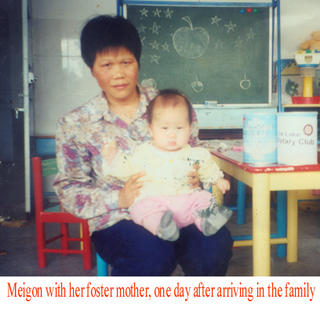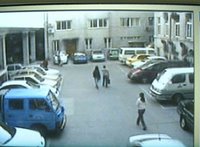
“Meigon, stop crying! It is just a little water!”
As I sat in the Chinese taxi, my mind reflected back on how many times I had uttered, sometimes yelled, those words to my daughter. Meigon has always hated to have water on her face. From the day she joined our family at eighteen months, washing her hair has usually resulted in a screaming child and a frustrated parent. No matter how hard we tried to carefully rinse her hair, invariably some water would cascade down her forehead into her eyes, eliciting a scream and tears. Even now, at five years of age, Meigon still requires a washcloth to cover her eyes as we wash her hair.
When we go swimming, it isn’t any easier. I have tried over the past year to increase her comfort level in the water by swimming with her, coaxing her to take ever greater risks in water play. This past Summer we purchased a pool pass that allowed us to swim almost daily. It was only as the Summer drew to a close that she was able to finally bring herself to plug her nose, close her eyes, and dunk her head quickly under water.
As a father, I find this fear of the water incomprehensible. Consequently, I push Meigon, gently chiding her for her fears. I have at times lost my temper with her, yelling at her to grow up and be a big kid, one who isn’t afraid of the water. I promise her that if she would just learn to swim, we would be able to have lots of fun river rafting, swimming in the ocean, and other activities that at this point are just distant promises.
But now, as I sit in the taxi in Guangzhou, my heart is heavy with guilt.
Like most adoptive families, I tried to make contact with Meigon’s foster family following her adoption. Before making the adoption trip for Meigon in March 2002, I wrote a letter to her foster family telling them how thankful I was for the love and care they had given her. I promised them that if possible I would always allow them to be part of her life. I closed the letter with my address and 800 yuan as a small token of my deep gratitude.
As I handed the letter to the orphanage worker, she immediately asked me if my name and address were in the letter. Knowing that the letter would probably be opened anyway, I answered positively. She told me that I would need to remove that information before she would be able to pass it on to the foster family. Regretfully, I tore my name and address from the bottom of the letter, knowing that the only connection I would have with them was being severed.
Over the next several years I returned to the orphanage frequently, each time asking the name of the foster family, and each time being denied any information. On several of these trips I also brought Meigon, who did her best to have large, tear-filled puppy eyes in order to move the orphanage to letting us know the foster family’s whereabouts. All to no avail. It seemed that we would never be successful in getting this important link to Meigon’s past.
A few months ago we received the smallest of bits of information. My wife, in talking with the orphanage, told them that Meigon had begun questioning us about her past. Questions frequently centered around Meigon’s “China family.” “As a mother, how should I answer her questions?” Lan asked our orphanage contact.
The foster family, we were told, was about 50 years old, had a son and a daughter, and lived in Longdong, a village close to the orphanage. Excitedly, I told Lan that all we needed to do was head to this village and ask around. We would easily find them, I assured her. The next morning my wife and I headed with our three girls on our hunt.
When we arrived in the “village” we discovered that rather than being a small collection of rural farm houses, Longdong was in fact an expansive sweep of hundreds, if not thousands of high-rise apartment complexes housing close to 20,000 people. Looking up from the hot street, I saw that finding Meigon’s foster family was going to be like looking for a needle in a haystack. With heavy heart and little conviction of success, we began to walk down the first street.
Hours later, we were just about to give up when we approached a group of motorcycle taxis parked at an intersection. Lan asked them if they knew of any families that took care of children for the “
Fuliyuan”, the nearby orphanage. One driver spoke up that he might know of one family, but wasn’t exactly sure where they lived. We got on his motorcycle, and headed into the concrete jungle.
After driving around for what seemed like an eternity, the driver admitted that he didn’t know where the family lived. He said that he would go ask his wife, and took off. I thought we would probably not see him again. The girls and I waited for 20 minutes, when suddenly our driver re-appeared and informed us that his wife knew where the family lived. Off we went, arriving after a short ride at the first foster family’s home.
After excitedly asking the foster mother if she knew “
Hai Yue”, Meigon’s orphanage name, we learned that Meigon wasn’t one of the girls she had cared for. She did, however, know of two other foster mothers who might be of help. We walked down the scorching street to the neighborhood market, where we indeed located two other foster mothers, neither of whom had cared for Meigon. We took our token pictures, made a list of the children all three women had cared for, and with three tired girls in tow, we called it quits.
After I had returned home to the States with Meikina and Meigon, Lan called the first foster mother and asked if she had found any other families. The foster mother told Lan she would ask around and call her back. Thinking that she was at a dead end, Lan all but gave up when a week later the phone rang and the foster mother began asking Lan in-depth questions concerning Meigon’s age, adoption date, physical appearance, etc. After answering her questions, the foster mother told Lan she might have located Meigon’s foster family.
With these developments unknown to me in the U.S., I decided to return to China a month later to spend a few weeks with Lan celebrating our one-year anniversary. Almost as soon as I entered her house, Lan gave me her anniversary present, a silk photo album. “Open it ” She insisted. Anxiously I opened the front cover to stare down at an infant photo of Meigon. “I found her foster family,” Lan announced. Tears welled up as I looked at the many pictures Lan had found of Meigon with her foster family. The quest I had started more than four years ago was nearly over.
We arranged a visit for the next morning, and headed back to Longdong to spend a few hours with the foster family. After exchanging photos, and telling them about Meigon’s life, I asked if there were any stories they could tell me about the year she had spent in their care. She had arrived in the foster family at six months of age, and I knew that this family had witnessed some of Meigon’s most important milestones. After a few seconds thought, the foster mother began to tell me of one particularly important event.
It was shortly before the New Year Festival (December 2001), she began. She had taken Meigon, who was by this time able to walk and climb upstairs, to her roof to play while she did the laundry. It was mid-morning, and the air was cool. After watering her small garden from the large cistern on the roof, she began hanging the laundry.
Meigon enjoyed exploring the roof area, the foster mother explained, and so she took no particular notice of her whereabouts.
Unknown to her foster mother, Meigon had climbed up on the shelf next to the cistern. Leaning over the edge, she looked down at her reflection in the dark water below. Slowly, she reached her hand down into the half-empty container, realizing too late that she had lost her footing and was slipping into the narrow throat of the container. As she crashed into the water, she feverishly tried to get her head above the surface, only to discover that her short arms weren’t long enough. Wedged upside down between the sides of the cistern, Meigon panicked and cried, then took in water. Her small body collapsed, leaving only her small feet above the water’s surface.
Her foster mother looked around with a start. Where was that girl? she thought. After glancing around the rooftop area, she walked to the edge of the staircase, thinking that perhaps Meigon had headed down. Calling down, she heard no reply. Puzzled, and growing increasingly concerned, she once more glanced around the garden, under each planter, until her eyes fell upon the cistern. Walking over she glanced down into the water.
Her husband heard the scream from their apartment two stories below. He ran upstairs to find his wife pulling Meigon’s lifeless body from the cistern. Meigon’s flesh was cold, her complexion ashen. Holding her by the ankles, they shook her body until some water fell from her open mouth. Seeing no improvement, they laid Meigon’s body on the floor and began to push her lungs. Water gushed from her mouth, and after several seconds Meigon gasped, then began to cry.
It would take the family almost two hours to warm her chilled body, indicating that she had been in the water for ten minutes or more. No doubt the cold water had saved Meigon’s life, since it slowed her metabolism enough to prevent her from dying upside down in the cistern. Two months later she was returned to the orphanage, and four weeks after that I arrived in China with Meikina and her Uncle Mike to bring her home.
As I sat in the taxi returning from our visit with Meigon’s foster family, an icy chill ran down my spine. I fully realized that for a twist for good fortune, Meigon would not be in our family today. I tried to push back the images of fear and terror that must have consumed my daughter’s mind in the last seconds of consciousness as she vainly tried to save herself in the cistern. I promised myself that I would call her as soon as I could to tell her how much I loved her, and how sorry I was for being inconsiderate of her fears. As I glanced out of the taxi window, I reflected that the most valuable thing I had obtained was not the photos I had received, but a story about Meigon’s past. This incident is a key that has opened a door through which I could now enter to understand who my daughter was. Like a stone cast into still waters, the events on her foster family's roof-top continue to cast ripples on the waters of Meigon's life.
 The shirt caught my eye as I walked along the market street of Dali's "Old Town" in the Western Province of Yunnan, China. "I Have No Money" it stated simply in Chinese. Boy, I thought, I should get that shirt to wear on my trips.
The shirt caught my eye as I walked along the market street of Dali's "Old Town" in the Western Province of Yunnan, China. "I Have No Money" it stated simply in Chinese. Boy, I thought, I should get that shirt to wear on my trips.














